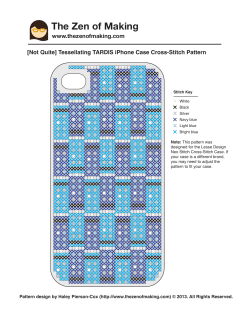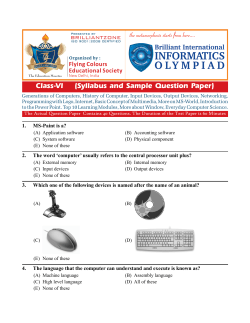
AIR-BB NEO 516 AIR-BB NEO Point to Point links
PTP AIR-BB NEO 516 AIR-BB NEO Point to Point links The AIR-BB NEO to Point link performance is strongly related to radio link quality and efficiency of the access protocol that decides when to transmit and what to transmit. While the link quality is much related to physical aspects such as distance between links, allowed output power in the frequency band and level of interference from other systems, the access protocol used on top of the physical layer plays a key role in how efficient the physical resources can be utilized. AIR’s Wireless Broadband products is using a proprietary Time Division Duplex (TDD) protocol, AIR-BB NEO 516, which optimizes the performance of our point to point links. All AIR-BB NEO 516 products can be managed via Web interface (SNMP) as well as with the RCS Server Based Managements system. The AIR-BB NEO portfolio can also be monitored by the free AIR Cloud Network. Operating in the 5 GHz unlicensed band at a data rate up to 245 Mbps aggregated throughput, the AIR BB NEO 516 TDD is designed to reliably transport your data, voice and video communications in virtually any environment – high-interference and long range line-of-sight paths, over water and open terrain, even in extreme weather conditions. TDD Multipoint support TDD based software High interference resistance AIR-BB NEO 516 uses TDD technology to emu¬late full duplex traffic over a half duplex communication link. The radio link oper¬ates symmetric or asymmetric and optimiz¬es the link for low latency. The proprietary TDDbased protocol greatly reduces the impact of long distances compared with other technologies. By using TDD based technology we en¬hance and strengthen the link against in¬terference. TDD Synchronization Using the SyncMaster-300, radio synchronization with GPS can be done with superb performance. Both together or separate between units at one or sev¬eral Point to Point and Multipoint sites also possible. AIR-BB NEO 516 TDD can be configured to run multipoint with up to 16 clients. In multipoint mode 16 timeslots are allo¬cated and each client can be assigned 1-8 slots. For example using four clients, the clients can be assigned 8-4-2-2 timeslots getting 50/25/12.5/12.5% of the capacity. AIR-BB NEO 516 TDD uses advanced interfer¬ence resistance techniques to assure ex¬cellent operation in harsh conditions in licensed or unlicensed bands. Combined with OFDM, AIR-BB NEO 516 TDD uses MIMO 2x2 and antenna diversity tech¬nology to achieve wireline speeds over ra¬dio. The built in antenna is dual polarised to achieve either higher throughput with dual streams or better link budget with single stream. Product Highlight • 245 Mbps aggregated throughput • Up to 80/20 asymmetrical traffic • 5.150 –5.845 GHz • 16 dBi Dual Polarized antenna • TDD Synchronization • TDD Multipoint support (up to 16 units) • Variety of channel widths: 5/10/20/40 MHz • Build-in RF ESD/Surge protection • Easy alignment with LED • Advanced spectrum analyzer • QoS: Four traffic classes prioritize traffic • Free Network Management Configurable QoS AIR-BB NEO 516 TDD uses four transmit queues to prioritize traffic, the classification is based on DiffServ and/ 802.1p. The clas¬sification is configurable to give the user full freedom of how the traffic should be prioritized. Ackerstraße 69 49084 Osnabrück Germany Tel: +49 (0)541 999 700 21 Fax: +49 (0)541 999 700 29 Email: info@air-broadband.de AIR-BB NEO 516 Inbuilt Antenna Gain, typ. 3 dB-Beam-Width, H-Plane, typ. 3 dB-Beam-Width, E-Plane, typ. Polarization F/B Ratio Cross Polarization, max. Port to Port Isolation Ethernet Interface Type Number of Ethernet Ports Framing/Coding Traffic Handling Data Latency Packets/second VLAN ID for Management Power over Ethernet Connector Management Link Management Protocol NMS Application Tools in web interface Certifications Radio 5.150 – 5.845 GHz 5/10/20/40 MHz 245 Mbps TDD OFDM, BPSK, QPSK, 16QAM, 64QAM 23 dBm -97 dBm FEC; k=1/2, 2/3, 3/4, 5/6 128 bit AES & MAC level Authentication 15kV Yes Four Access Categories (AC) Voice, Video, Best Effort, and Background. Traffic classification according to WMM Type 10/100/1000 BaseT Interface with Auto-negotiation (IEEE 802.3), Manual 1 IEEE 802.3u MAC layer bridging, self-learning 802.1q transparent 2-4ms (3ms typical) > 40 000 Supported 48V DC, 802.3af, <6W typical RJ-45 Web interface SNMP AIR Cloud Network RCS Management Service Spectrum Analyser, Speed Test Health Environment IP Code Temperature Size Weight per unit IP63 -40° / +55° C 250 x 210 x 80 mm 1.1 Kg Safety AIR-BB NEO 516 <1 km 245 Mbit 2 km 243 Mbit 3 km 170 Mbit 4 km 130 Mbit 5 km 85 Mbit 6 km 84 Mbit 7 km 64 Mbit 8 km 64 Mbit Throughput UDP, 30dB max ETSI EIRP, 6dB margin Electrical 16 dBi 30° 17° Dual, Vertical and Horizontal -30 dB -28 dB -30 dB FCC Part 15.247 ETSI: EN 301 893 V1.5.1 ETSI EN 302 502 V1.2.1 FCC part 15 class B EN 55022:2010 Class B EN 55024:2010 ETSI EN 301 489-1 V1.9.2 ETSI EN 301 489-17 V2.1.1 IEC 60950-1 EN 60950-1 EN 62311:2008 EMC Distance Radiations Patterns Vertical Polarization E-Plane Pattern H-Plane Pattern Horizontal Polarization E-Plane Pattern H-Plane Pattern PTP Radio Frequency Bands Channel widths supported Capacity Duplex Technique Modulation Max Tx power Max Rx sensitivity Error Correction Encryption Surge Protection DFS QoS
© Copyright 2025


















